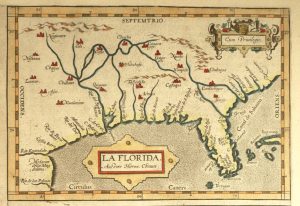Early Colonial (1520–1715)

Maps Etc
In North Carolina, we define Early Colonial as the period involving primarily non-permanent European connections. This is certainly not meant to imply that these connections were fleeting in terms of their impact on Indian groups, but that the settlements themselves did not last for very long. Some of the earliest expeditions specifically dealing with North Carolina began during the 1520s, with Verrazano’s 1524 exploration being perhaps one of the most well known. This time period also encompasses some other well known North Carolina sites, such the establishment of Fort San Juan at Joara by Juan Pardo and both attempts at establishing a colony on Roanoke Island by the English. Small, more permanent settlements begin in roughly 1650, when European settlers begin to move into Indian lands along the coastal sounds and rivers of North Carolina. As settlements increase, so too do conflicts with groups like the Chowanoc and Weapemeoc; this period culminates with the Tuscarora War that lasts from 1711-1715. The treaty signed with the remaining Tuscarora in 1715, placing them on a reservation along the Pamlico River, marks a turning point in North Carolina’s early history and is where we delineate the end of the Early Colonial.
